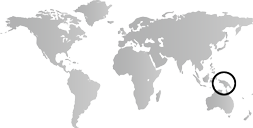By 1800, European explorers had been gradually encountering and charting the islands of Melanesia for more than two centuries and the Spanish had made a brief and unsuccessful attempt to establish a colony in the Solomon Islands. However, it is not until the nineteenth century that broader sustained contact between Melanesian peoples and the West begins to have a substantial impact on the region’s arts and cultures. Following, and occasionally adding to, the discoveries of the early explorers, sailors on European and American commercial vessels are the first outsiders to establish lasting, though often volatile, relations with many Melanesian groups. In the 1820s, Western traders start to scour the region for sandalwood, an aromatic timber highly valued in the China trade, which the islanders exchange for Western goods. The trade ends in the 1860s as supplies become depleted, but by this point whalers have been active in the region for decades in search of whales and provisions.
As elsewhere in the Pacific, Westerners—generally unintentionally but, in rare instances, deliberately—introduce new diseases that devastate the populations on many islands. Unlike other areas of the Pacific, however, local diseases, particularly malaria, also take a heavy toll on Westerners. In 1839, the first Christian missionaries begin to arrive. Most initially meet with little success and some are killed outright by their prospective converts. Apart from a nominal claim to western New Guinea by the Dutch in 1828, Melanesia’s reputation for hostility (as resistance to foreign incursions is seen by Western observers), greater incidence of disease, and perceived lack of economic resources (beyond the dwindling supplies of sandalwood) cause the colonial powers to largely ignore the region until the latter half of the century.
During the second half of the century, the pace and extent of Western contact and influence intensify. Missionaries begin to achieve greater success in converting local populations. European planters and other settlers replace the more transient whalers and sandalwood traders. In the 1850s, the European colonial powers begin to assert sovereignty over the various regions of Melanesia. In 1853, France claims New Caledonia, where it later establishes a penal colony. Between 1864 and 1897, more than 21,000 French convicts are sent to the archipelago. Following earlier, more preliminary, claims and discussions, in 1886 Britain and Germany formally divide the eastern half of New Guinea and partition the Solomon Islands in 1893. In 1898, the western half of New Guinea becomes officially incorporated into the Dutch East Indies (modern Indonesia). At the same time that more Westerners are arriving, large numbers of Melanesians leave their homelands. Starting in the 1860s, thousands of Melanesians from Vanuatu, the Solomon Islands, and later New Guinea are, at times forcibly, recruited as laborers to work on sugar and cotton plantations in Australia and Fiji. The practice continues into the early twentieth century.
Despite the threefold impact of colonialism, missionization, and labor recruitment, the majority of Melanesian arts survive the nineteenth century intact, although some, such as New Caledonian wood sculpture, begin to decline as a result of growing cultural disruption. For the most part, however, the region’s vast variety of sculptural traditions continue to flourish, and are even, at times, assisted by the introduction of Western goods such as steel tools. The broader exploration and increasing settlement of the region by Westerners also reveal the astonishing breadth and diversity of Melanesian art to the wider world for the first time. Continuing the process begun by their eighteenth-century predecessors, explorers, scientists, settlers, and even missionaries assemble large collections of Melanesian works and document the artistic and cultural achievements of the hundreds of individual peoples who inhabit the region’s sprawling archipelagos. In 1885, German explorers are the first outsiders to sail up the Sepik River in northern New Guinea, encountering what is perhaps the single richest concentration of artistic traditions in all of Oceania.


